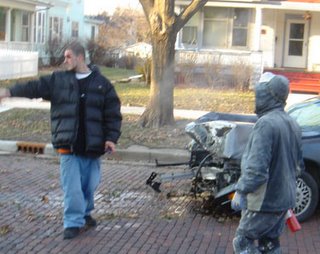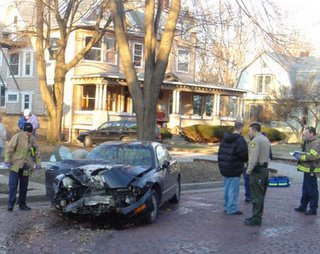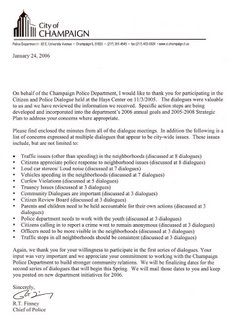After more than two years of waiting and a rotation of State's Attorneys, Shamsul Chowdhury, father of
Nadia Chowdhury the University of Illinois Sophomore who was fatally struck by two cars on the corner of Fourth and John Streets in Feb 2004, learned this week that reckless homicide charges pending against Ioannis Tziligakis (one of the motorists who struck her) were dropped.
Mary Shank of the News-Gazette reports, Chowdhury was “grief stricken” by the news. Dr. Chowdhury’s reaction is not surprising given the many months he waited out the continuances, only to learn that justice was not forthcoming. His ongoing frustration with the State’s Attorney’s handling of the case is understandable. But State's Attorney
Julia Rietz, who took over the case from former Assistant State's Attorney Steve Zeigler last year and claimed to have been motivated “to take special care” in examining the facts of the case before deciding to drop the reckless homicide charge, said of Chowdhury, "I cannot act on emotions or do what he wants me to do to ease his pain." But did Rietz's own emotions cloud her judgment and lead to a shoddy review of the record? Several inconsistencies in her analysis seem to suggest she may have.
In what appeared an effort to both distance herself from her predecessor (who made the original recommendation) and to correct Dr. Chowdhury of his "emotional" response (as if one cannot be both emotional and rational) Rietz took some unusual steps to prove the case lacked merit, notably a strange re-staging of the events at Fourth and John to inform her decision, one which involved her husband, several passing students, and a stop watch.
Her investigation not only involved a bizarre (and unscientific) reenactment of the fatality but also yielded an equally bizarre set of assumptions and conclusions that contradicted eye-witness accounts. "If he [Ioannis Tziligakis] had been careening around the corner without paying attention, he wouldn't have immediately stopped.” While less than convincing, it is curious how this logic does little to serve Rietz's decision to drop charges. If Tziligakis was
not careening without paying attention, he must have been proceeding normally and paying attention. The assumption that Tziligakis was paying attention (i.e. was conscious of his surroundings) when he struck Nadia Chowdhury is an odd defense and goes more to
support the charge of reckless homicide than it does vacate it. It suggests he would have
had to have seen her (after all, everyone else who was "paying attention" did) but proceeded into the intersection
anyway without regard for her safety. (Recklessness = Conscious disregard of substantial and unjustifiable risk.)
That Tziligakis saw Nadia when he entered the intersection is compelling, since numerous witnesses on the scene claim to have also seen her enter the intersection; at least three admitted noticing her because she was particularly attractive and alert. Several witnesses state she entered the intersection before any car did, and was well into it when she was struck. One witness Paris Chandler, who was a passenger in the car behind Tziligakis and saw her half-way through the intersection, was incredulous in statements he gave to police at the scene, "He could not believe that [the] Hyundai's driver [Tziligakis] didn't see Nadia, since he could clearly see her." And Terrell Ware, the driver of the car in front of Tziligakis, which Tziligakis overtook shortly before striking Nadia, said, "I see her of course...I didn't think this person would not see her." Another witness, Ivan Wojtecki, described the intersection as "well it." He and two of his friends walking at Fourth and John passed her as she was crossing the street and stated the intersection was clear of cars. And most significant are Tziligakis's own comments, which he gave to Officer Ganesh Reddy at the scene. "As he [Tziligakis] turned, he noted a female (Nadia) crossing the street on the north side of the intersection going from east to west." Sabina Morkisz, Tziligakis's girlfriend, stated to police later that her boyfriend said to her, "he had been turning onto Fourth Street and the girl hurried to get out of the path of his car..." Nowhere does Tziligakis claim to have "not seen" her. From his own statements and those of witnesses, it is arguable that Tziligakis saw Nadia Chowdhury and took an unreasonable risk by proceeding into the intersection without slowing or stopping—and perhaps with the intention of intimidating; such is not entirely uncommon when aggressive drivers perceive pedestrians as moving too slowly.
Rietz's second assumption, that Tziligakis stopped "immediately" is also troubling. In favor of her own reenactment, she dismisses eye-witness accounts that have him not stopping immediately, but rather completing his turn after hitting Nadia and parking some distance away from the victim; so too is her theory of the timing ("a split second") between the first and the second strike which is not consistent with a single witness statement. The parking of his automobile alone, as described by those interviewed, had to have taken a number of seconds. Were the split second theory true, she would not have had time to hit the ground, let alone lie there long enough to be described by witnesses as being on the pavement, face up, and motionless. Nevertheless, it was a fast sequence of events.
N-G reporter Mary Shank offers an unsubstantiated description of Tziligakis's motives and actions: "Realizing he hit her, Tziligakis immediately stopped to help her..." Where does this statement come from? She attributes it to no one but asserts it as truth and therefore misleads her readers. There is no evidence in any document or statement that I've read to suggest Tzilgakis stopped “to help”. One eye-witness offered a completely different view of Tziligakis’s actions immediately following the collision:
Terrell Ware, driver of the car in front of Tziligakis and the only African American witness, describes seeing the impact and seeing Nadia "lurch" forward and hit the ground. He describes Tziligakis as "pausing" briefly after hitting her, presumably to take stock of what had just happened, and then proceeding with his turn and pulling over and parking. In his comments to police, Ware was as incredulous as Paris Chandler:
I just can't believe what had happened...just can't believe how someone can...someone that, somebody else's negligence like that. I mean, the young lady got hit...then the person that hit her gonna move from the scene of the accident
He later reflects:
...I also go back to that person that left her in the middle of the street and parked to the side. I mean, giving those people that came after him no sign of nothing to take precautionary action for…which makes it seem like nothing was wrong.
Another witness, Bill Kennedy who heard both the impact and the scream and turned to see Nadia lying in the road as Tziligakis veered away, said, “he’d stepped off the curb to try and help the girl [Nadia] as she was screaming for help.”
Tziligakis himself claims to have heard Nadia scream and to have seen her fall—Why then continue at all? Why not alert on-coming motorists by opening a door, flashing lights & hazards, especially if they are, as Rietz contends, a "split second" away? He knew he hit her; it was the first statement he made to Police at the scene: “I hit her,” he said. [It’s worth noting that he changed his story a number of times after this.] Why continue moving if, as Mary Shank imagines, Tzilgakis wanted to "help." A better explanation—one based on the witness’s statement—is that he delayed for a split second (probably long enough to think, Oh Shit!) then, out of concern for his own person and his own vehicle, moved out of harms way—the harm he had just created by making a reckless turn in the first place.
It wouldn't be the first time Shank got her facts about the case wrong. In a previous
News-Gazette article from 2005 she has Tzilgakis running a red light. It seems Julia Rietz is not the only one skimming police reports and coming to careless conclusions.
After reading the Police report myself and visiting the intersection on a number of occasions and at different times of day and night… I believe the truth can be discovered by way of two possible scenarios. Either Tziligakis saw Nadia or he didn’t.
- If he did not see Nadia, which, given the conditions and given the fact that every witness on the street at the time saw her and that the area was well lit, then he did not make a proper stop at the stop sign and adequately absorb his surroundings before proceeding, which suggests negligence
- If he did see Nadia and proceeded anyway (taking an unjustifiable risk), then his actions suggest recklessness, perhaps even meaning to intimidate.
Rietz, however, would have us believe a tautology… Namely that Tziligakis was paying attention because he could not have not been [paying attention]. This is based on the even shakier logic that anyone who is able to immediately pull over after hitting someone cannot have hit that person recklessly. Never mind that plenty of reckless drivers can –and do– pull over after hitting someone, especially if there are a dozen witnesses present.
Moreover, that she dismisses Terrell Ware’s version of the events for her own reenactment, borders on absurdity. In a letter to Shamsul Chowdhury she dismisses Ware’s statement of being overtaken on the left by Tzilgakis because “it is physically impossible to pass another car at that part of Fourth Street. There are parked cars on either side of the street at all times, and the remaining lanes are not wide enough for two cars to pass.” This, as anyone who’s been to Fourth at John Street (a wide one way street) knows is ludicrous. (Click on image below for full view.)

While it is indicitive of her high energy that Rietz went to so much trouble to stage a reenactment of the events, the public would have been better served had she taken more care in reading the police reports and speaking to witnesses, and left the foresenics to
those who specialize in reconstructing accident scenes.
Based on my review of the evidence, I did not believe that we would be able to prove reckless homicide," Rietz said, adding that during the last couple of months she did an exhaustive review of the police reports.
But it is highly unlikely that she gave these reports the scrutiny she claims. Consider the following statements she made in a letter to me on March 9, 2006. (This letter was in response to one I sent her.) Note: this letter is little more than a month old at the time of her decision to vacate based on lack of evidence.
Your understanding of what happened on February 21, 2004 is incorrect. Your account of the evidence is inaccurate. There is no witness who estimated that Mr. Yoon was going 35 miles per hour in a 25 mile per hour zone. There is no evidence that Mr. Yoon accelerated to shake “whatever he hit.” With regard to Mr. Tziligakis there are no witnesses that say he was driving aggressively. He did not refuse to take the breath test. There are no witnesses who say they heard Ms. Chowdhury scream. There are no witnesses who say that Ms. Chowdhury was knocked unconscious. There are no “several” witnesses who recount in detail the manner in which Mr. Tziligakis took the turn. In fact, there are no witnesses who actually saw the impact. I have personally reviewed the police reports. I am very familiar with the actual evidence in this case. You[r] understanding of that evidence is simply incorrect.
Note: scroll down to access table data
| Rietz | Police Reports |
"There is no witness who estimated that Mr. Yoon was going 35 miles per hour in a 25 mile per hour zone." |
Well as [regarding] the car, it was like going 35. It doesn't seem like that much, but as far as being on the sideline and looking at it...it was a lot... it wasn't slow at all.
-Terrel Ware to Officer Jeff Munds Supplementary/Continuation Report 704-1928 |
"There are no witnesses that say he [Tziligakis] was driving aggressively." |
There's a car. This car comes—I don't know if it was behind me or he sped up real quick—real quick. Fast. In a hurry to get that close and pass me at that time. But this car come and pass me. I didn't see him make a complete stop."
-Terrel Ware, Supplementary/Continuation Report 704-1928 |
"He did not refuse to take the breath test." |
A short time later I was told that (1) driver (Dong) would submit to a PBT test, but that the other driver [Tziligakis] would not.
-Officer David Griffet, Supplemental Report Ioannis [Tziligakis] was given the opportunity to submit to a PBT, however he declined.
-Officer Ganesh Reddy, Supplemental Report |
"There are no witnesses who say they heard Ms. Chowdhury scream." |
As Ioannis [Tziligakis] completed his turn he saw Nadia at the front of his car on the driver side. She then "screamed and lost her balance."
-Ganesh Reddy, Supplemental Report Bill [Kennedy] then heard a scream and looked in the direction of the scream and saw the female laying in the road.
-Officer Jeff Munds, Supplemental/Continuation Report 704-1928 |
"There are no witnesses who say that Ms. Chowdhury was knocked unconscious." |
And her arms was just laid out and she wasn't moving. And she wasn't saying anything or nothing. No, showing, no sign of motion at all.
-Terrel Ware to Officer Jeff Munds, Supplementary/Continuation Report 704-1928 |
"There are no “several” witnesses who recount in detail the manner in which Mr. Tziligakis took the turn." |
**See Ware statement above and Chandler statement below about driving aggressively. Paris [Chandler] stated that he had seen Nadia walking westbound in the intersection's north crosswalk. When he saw the Hyundai turning, "he started freaking out" because he could see that the vehicle was going to strike Nadia.
-Officer Gregory Manzana, Supplemental Report Note: These are just two, but there might have been more had she followed up and contacted witnesses at the scene who were not asked about the turn itself.
|
"There are no witnesses who actually saw the impact." |
What was in my mind was, wow he's making a pretty sharp turn...that's when she was struck and fell...She was hit in a space between the middle--driver's side tire and the middle of the drivers door. In that area is what she was hit by.
Paris Chandler to Officer Jeff Munds, Supplementary/Continuation Report 704-1928 |
In Conclusion
My sentiments regarding the Chowdhury tragedy are no secret. I have adamantly called for tougher penalties on car crimes, believing they ought not enjoy the special status they currently do. Car crimes are far more serious than bar skirmishes, yet I read constantly of kids who throw a punch or shove someone winding up with 2 years probation and a criminal record even when no one is injured. The State's Attorney pursues these types of crimes vigorously even while they often have no bearing on the public's well-being.
That car crimes are given far less attention and often result in no criminal record is a serious problem with our justice system; they linger on the first floor in the Circuit Court's Office and until very recently violators could opt for dozens of "court supervisions" and avoid a record. State of Illinois this year passed a law limiting court supervision to no more than 2 per year.
Commitment to pursuing convictions for those who kill with their cars is the only way to deter drivers from casually speeding, rolling or running stop signs, and driving aggressively. If the staggering death toll is EVER to come down from the tens of thousands it currently claims annually, then lawmakers need to be serious about making the punishments fit the crimes.
I do not know if there was enough evidence in the case of Ioannis Tziligakis to convict him of reckless homicide; probably not given the current attitudes toward car crimes. But I believe strongly in working towards eliminating the excuses available to those who kill with cars. That means pursuing every possible opportunity to bring those involved in vehicular crimes to justice. There were opportunities in the Chowdhury case that were ignored and the community will undoubtedly suffer because of it.
States Attorneys looking out for their conviction record are often reluctant to take chances if a conviction is not assured, but that's their job and they need to take it or leave it.
See Also:
Father doesn't get his wish - Daily Herald
Illinipundit Open Thread

Secondly, while the trailer you placed at the 600 block of W. Hill Street was a welcome addition (cars did slow down significantly for it), it does little to address the long term problem of speeding on W. Hill Street and the use of our street as a crossover to downtown. It most certainly works as a temporary traffic calmer, but it should not be considered a data collector, representative of the average speeds on our street when the device is not present. The device is visible from as far back as Prospect Street and drivers will automatically slow to the speed limit when they see it.







